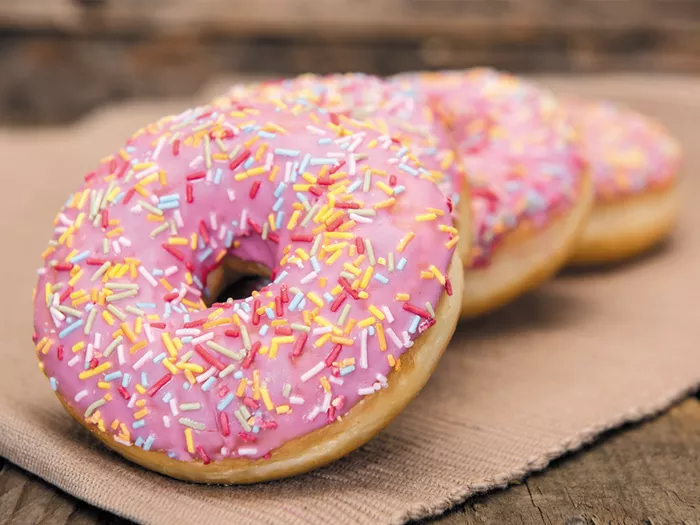Donuts, those delightful treats loved worldwide, owe much of their appeal to their glazes. A well-crafted glaze can elevate a simple ring of dough into a confectionery masterpiece. But what exactly goes into making donut glazes that adorn our favorite pastries? This article delves deep into the world of donut glazes, exploring their ingredients, techniques for application, and the diverse array of glaze types that cater to every palate.
Introduction to Donut Glazes
Donut glazes serve multiple purposes beyond mere decoration. They provide a glossy finish that enhances visual appeal, seals in moisture to maintain freshness, and adds a burst of flavor that complements the dough’s sweetness. The formulation of a glaze involves a careful balance of ingredients to achieve the desired texture, flavor, and appearance.
Key Ingredients in Donut Glazes
Sugar: The backbone of most glazes, sugar provides sweetness and contributes to the glaze’s texture. Common sugars used include powdered (confectioner’s) sugar, granulated sugar, and brown sugar, each imparting distinct characteristics.
Liquid: Liquid components such as water, milk, cream, or fruit juices are essential for achieving the desired consistency of the glaze. They also play a role in dissolving the sugar and facilitating a smooth texture.
Flavorings: Vanilla extract, almond extract, citrus zest, or other flavorings are added to impart taste and aroma, elevating the overall sensory experience of the donut.
Colorants: Food coloring or natural extracts like beet juice or turmeric are used to tint the glaze, enhancing its visual appeal and allowing for creative presentations.
Thickeners: Cornstarch or other thickening agents help control the viscosity of the glaze, ensuring it adheres to the donut without dripping excessively.
Types of Donut Glazes
Donut glazes come in various forms, each offering unique textures and flavors:
Classic Vanilla Glaze: Made with powdered sugar, milk, and vanilla extract, this glaze is beloved for its simplicity and sweetness.
Chocolate Glaze: Incorporating cocoa powder or melted chocolate, this glaze provides a rich, indulgent coating.
Maple Glaze: Featuring maple syrup or maple extract, this glaze adds a distinctive sweetness reminiscent of pancakes.
Fruit Glazes: Using fruit juice or puree (e.g., lemon, strawberry), these glazes offer tangy and refreshing flavors.
Coffee Glaze: Infused with coffee or espresso, this glaze appeals to coffee lovers with its robust flavor profile.
Techniques for Glazing Donuts
Achieving a perfectly glazed donut requires precision and technique. Here are the steps involved in glazing:
Preparation: Ensure the donuts are cooled to room temperature before applying the glaze to prevent excessive absorption or melting.
Mixing the Glaze: Combine the ingredients in the correct proportions, adjusting the consistency as needed by adding more liquid or powdered sugar.
Dipping Method: Dip the top of each donut into the glaze, allowing excess to drip off. For even coverage, rotate the donut slightly while lifting it out of the glaze.
Pouring or Drizzling: Use a spoon or piping bag to pour or drizzle the glaze over the donuts for artistic effects or to cover irregular shapes.
Setting: Allow the glaze to set and dry completely before serving or storing the donuts to maintain the desired texture and appearance.
Innovations and Trends in Donut Glazes
As culinary trends evolve, so do donut glazes. Modern interpretations may include unconventional ingredients like matcha powder, lavender essence, or even savory elements like bacon or herbs. The rise of gourmet donut shops has spurred experimentation with exotic flavors and textures, pushing the boundaries of traditional glaze recipes.
Cultural Significance of Donut Glazes
Donuts and their glazes hold cultural significance across the globe. In the United States, for instance, the ubiquitous glazed donut symbolizes indulgence and comfort, while in European countries, variations like Berliners and beignets showcase different glazing techniques and flavor profiles. In Asia, donuts are often lighter and less sweet, with glazes tailored to local tastes such as matcha or red bean paste.
SEE ALSO: Donut Frying: What Temperature to Fry Donuts?
The Science Behind Glaze Consistency
The consistency of a donut glaze is crucial for both aesthetic appeal and functional performance. Factors influencing consistency include:
Sugar Ratio: The proportion of sugar to liquid affects how thick or thin the glaze will be. More powdered sugar yields a thicker glaze suitable for dipping, while less sugar creates a thinner, pourable consistency.
Temperature Control: Glaze viscosity changes with temperature; colder glazes are thicker and set faster, while warmer glazes flow more easily and may require additional time to dry.
Humidity: High humidity can affect glaze drying times and may necessitate adjustments to the recipe to achieve the desired texture and appearance.
Troubleshooting Glaze Issues
Even experienced bakers encounter challenges when glazing donuts. Common issues and their solutions include:
Too Thick: Add small amounts of liquid (milk, water, juice) until the desired consistency is reached.
Too Thin: Gradually incorporate more powdered sugar until the glaze thickens to the desired viscosity.
Uneven Coverage: Ensure the donuts are evenly cooled and dip them at a consistent speed and angle for uniform glaze distribution.
Health Considerations and Alternatives
While delicious, donut glazes are typically high in sugar and calories. Health-conscious consumers may opt for alternatives such as:
Gluten-Free Glazes: Made with gluten-free flours and natural sweeteners like honey or agave syrup.
Vegan Glazes: Using plant-based milk and margarine instead of dairy products, appealing to those following a vegan diet.
Reduced-Sugar Glazes: Substituting part of the sugar with natural sweeteners like stevia or erythritol to reduce overall sugar content.
Conclusion
Donut glazes are more than just a topping; they are an integral part of what makes these pastries irresistible. Whether classic or innovative, glazed donuts continue to delight taste buds and inspire creativity in the culinary world. By understanding the ingredients, techniques, and cultural nuances behind donut glazes, bakers can elevate their creations and satisfy the diverse preferences of donut enthusiasts worldwide. Embrace the art of glazing, and enjoy the sweet rewards it brings to both baker and consumer alike.

